越南光伏和太阳能电力的发展
越南电力市场分析
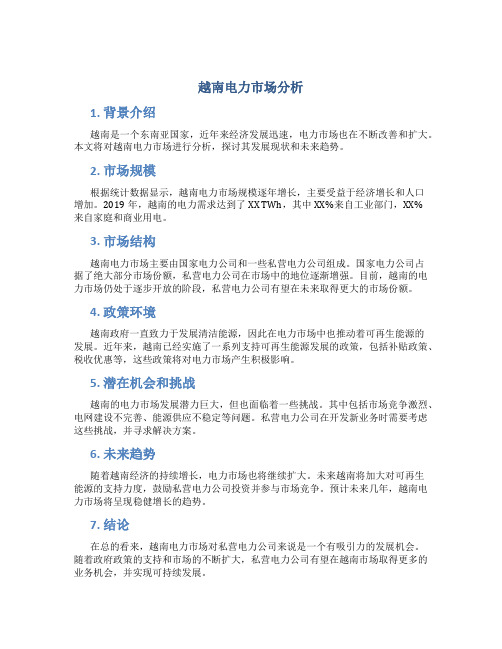
越南电力市场分析1. 背景介绍越南是一个东南亚国家,近年来经济发展迅速,电力市场也在不断改善和扩大。
本文将对越南电力市场进行分析,探讨其发展现状和未来趋势。
2. 市场规模根据统计数据显示,越南电力市场规模逐年增长,主要受益于经济增长和人口增加。
2019年,越南的电力需求达到了XX TWh,其中XX%来自工业部门,XX%来自家庭和商业用电。
3. 市场结构越南电力市场主要由国家电力公司和一些私营电力公司组成。
国家电力公司占据了绝大部分市场份额,私营电力公司在市场中的地位逐渐增强。
目前,越南的电力市场仍处于逐步开放的阶段,私营电力公司有望在未来取得更大的市场份额。
4. 政策环境越南政府一直致力于发展清洁能源,因此在电力市场中也推动着可再生能源的发展。
近年来,越南已经实施了一系列支持可再生能源发展的政策,包括补贴政策、税收优惠等,这些政策将对电力市场产生积极影响。
5. 潜在机会和挑战越南的电力市场发展潜力巨大,但也面临着一些挑战。
其中包括市场竞争激烈、电网建设不完善、能源供应不稳定等问题。
私营电力公司在开发新业务时需要考虑这些挑战,并寻求解决方案。
6. 未来趋势随着越南经济的持续增长,电力市场也将继续扩大。
未来越南将加大对可再生能源的支持力度,鼓励私营电力公司投资并参与市场竞争。
预计未来几年,越南电力市场将呈现稳健增长的趋势。
7. 结论在总的看来,越南电力市场对私营电力公司来说是一个有吸引力的发展机会。
随着政府政策的支持和市场的不断扩大,私营电力公司有望在越南市场取得更多的业务机会,并实现可持续发展。
以上是对越南电力市场的分析,希望能对读者更好地了解这一市场,为未来投资和业务决策提供参考。
以上是对越南电力市场的分析,希望能对读者更好地了解这一市场,为未来投资和业务决策提供参考。
光伏发电行业发展现状及未来发展趋势
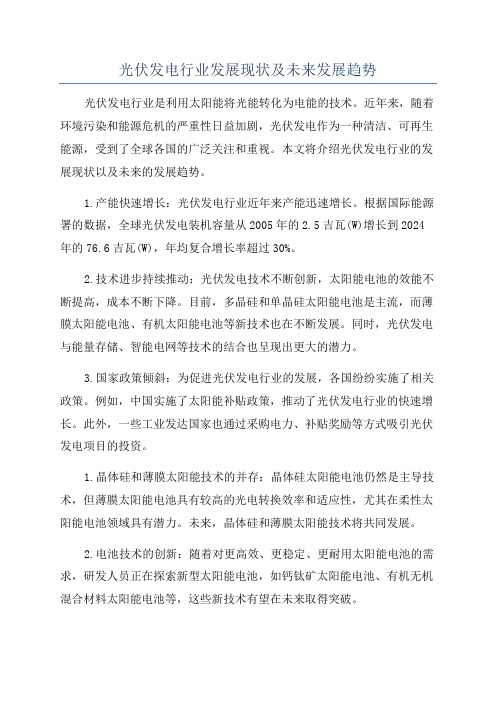
光伏发电行业发展现状及未来发展趋势光伏发电行业是利用太阳能将光能转化为电能的技术。
近年来,随着环境污染和能源危机的严重性日益加剧,光伏发电作为一种清洁、可再生能源,受到了全球各国的广泛关注和重视。
本文将介绍光伏发电行业的发展现状以及未来的发展趋势。
1.产能快速增长:光伏发电行业近年来产能迅速增长。
根据国际能源署的数据,全球光伏发电装机容量从2005年的2.5吉瓦(W)增长到2024年的76.6吉瓦(W),年均复合增长率超过30%。
2.技术进步持续推动:光伏发电技术不断创新,太阳能电池的效能不断提高,成本不断下降。
目前,多晶硅和单晶硅太阳能电池是主流,而薄膜太阳能电池、有机太阳能电池等新技术也在不断发展。
同时,光伏发电与能量存储、智能电网等技术的结合也呈现出更大的潜力。
3.国家政策倾斜:为促进光伏发电行业的发展,各国纷纷实施了相关政策。
例如,中国实施了太阳能补贴政策,推动了光伏发电行业的快速增长。
此外,一些工业发达国家也通过采购电力、补贴奖励等方式吸引光伏发电项目的投资。
1.晶体硅和薄膜太阳能技术的并存:晶体硅太阳能电池仍然是主导技术,但薄膜太阳能电池具有较高的光电转换效率和适应性,尤其在柔性太阳能电池领域具有潜力。
未来,晶体硅和薄膜太阳能技术将共同发展。
2.电池技术的创新:随着对更高效、更稳定、更耐用太阳能电池的需求,研发人员正在探索新型太阳能电池,如钙钛矿太阳能电池、有机无机混合材料太阳能电池等,这些新技术有望在未来取得突破。
3.光伏发电与能量存储的结合:光伏发电的波动性和间歇性是其面临的挑战之一,而能量存储技术的发展为解决这一问题提供了可能。
目前,电池储能和氢能储存技术是较为成熟的能量存储解决方案,未来光伏发电与能量存储的结合将更加紧密。
4.分布式光伏发电的发展:分布式光伏发电系统指的是将太阳能电池板安装在建筑物屋顶或其他合适场所,通过自发自用或向电网出售余电的方式发电。
随着技术成本的下降,分布式光伏发电系统将成为光伏发电的主流形式之一总之,光伏发电行业在持续技术创新和政策支持的推动下,发展迅猛。
越南光伏行业报告
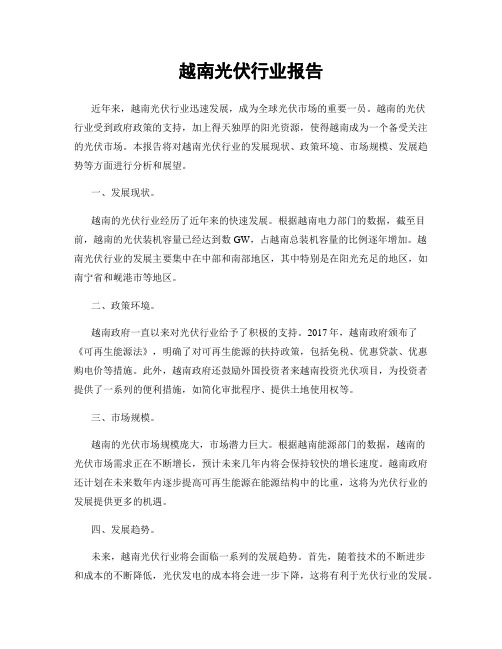
越南光伏行业报告近年来,越南光伏行业迅速发展,成为全球光伏市场的重要一员。
越南的光伏行业受到政府政策的支持,加上得天独厚的阳光资源,使得越南成为一个备受关注的光伏市场。
本报告将对越南光伏行业的发展现状、政策环境、市场规模、发展趋势等方面进行分析和展望。
一、发展现状。
越南的光伏行业经历了近年来的快速发展。
根据越南电力部门的数据,截至目前,越南的光伏装机容量已经达到数GW,占越南总装机容量的比例逐年增加。
越南光伏行业的发展主要集中在中部和南部地区,其中特别是在阳光充足的地区,如南宁省和岘港市等地区。
二、政策环境。
越南政府一直以来对光伏行业给予了积极的支持。
2017年,越南政府颁布了《可再生能源法》,明确了对可再生能源的扶持政策,包括免税、优惠贷款、优惠购电价等措施。
此外,越南政府还鼓励外国投资者来越南投资光伏项目,为投资者提供了一系列的便利措施,如简化审批程序、提供土地使用权等。
三、市场规模。
越南的光伏市场规模庞大,市场潜力巨大。
根据越南能源部门的数据,越南的光伏市场需求正在不断增长,预计未来几年内将会保持较快的增长速度。
越南政府还计划在未来数年内逐步提高可再生能源在能源结构中的比重,这将为光伏行业的发展提供更多的机遇。
四、发展趋势。
未来,越南光伏行业将会面临一系列的发展趋势。
首先,随着技术的不断进步和成本的不断降低,光伏发电的成本将会进一步下降,这将有利于光伏行业的发展。
其次,越南政府将会进一步加大对光伏行业的支持力度,为光伏行业创造更加良好的发展环境。
另外,随着光伏市场的不断成熟,越来越多的国内外企业将会进入越南光伏市场,促进市场的竞争和创新。
总之,越南光伏行业在政策的支持下,市场的需求下,技术的进步下,将会迎来更加广阔的发展空间。
未来几年,越南的光伏市场将会成为全球光伏市场的一颗新星,吸引着越来越多的投资者和企业的关注和参与。
希望本报告能够为关注越南光伏市场的投资者和企业提供一些有益的信息和参考。
国外光伏发展现状
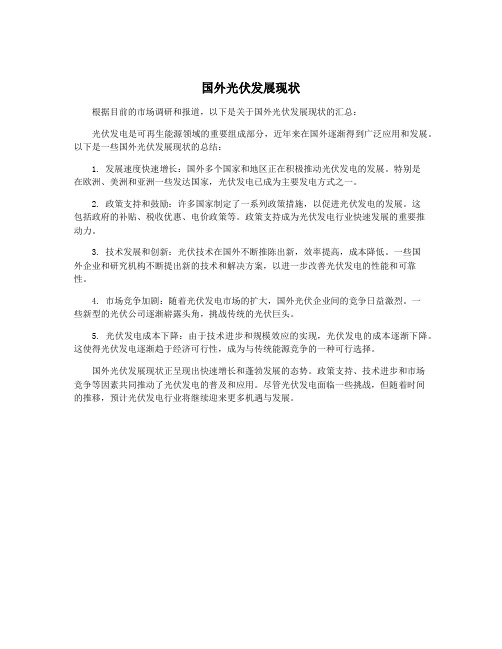
国外光伏发展现状
根据目前的市场调研和报道,以下是关于国外光伏发展现状的汇总:
光伏发电是可再生能源领域的重要组成部分,近年来在国外逐渐得到广泛应用和发展。
以下是一些国外光伏发展现状的总结:
1. 发展速度快速增长:国外多个国家和地区正在积极推动光伏发电的发展。
特别是
在欧洲、美洲和亚洲一些发达国家,光伏发电已成为主要发电方式之一。
2. 政策支持和鼓励:许多国家制定了一系列政策措施,以促进光伏发电的发展。
这
包括政府的补贴、税收优惠、电价政策等。
政策支持成为光伏发电行业快速发展的重要推
动力。
3. 技术发展和创新:光伏技术在国外不断推陈出新,效率提高,成本降低。
一些国
外企业和研究机构不断提出新的技术和解决方案,以进一步改善光伏发电的性能和可靠
性。
4. 市场竞争加剧:随着光伏发电市场的扩大,国外光伏企业间的竞争日益激烈。
一
些新型的光伏公司逐渐崭露头角,挑战传统的光伏巨头。
5. 光伏发电成本下降:由于技术进步和规模效应的实现,光伏发电的成本逐渐下降。
这使得光伏发电逐渐趋于经济可行性,成为与传统能源竞争的一种可行选择。
国外光伏发展现状正呈现出快速增长和蓬勃发展的态势。
政策支持、技术进步和市场
竞争等因素共同推动了光伏发电的普及和应用。
尽管光伏发电面临一些挑战,但随着时间
的推移,预计光伏发电行业将继续迎来更多机遇与发展。
国外光伏发展现状
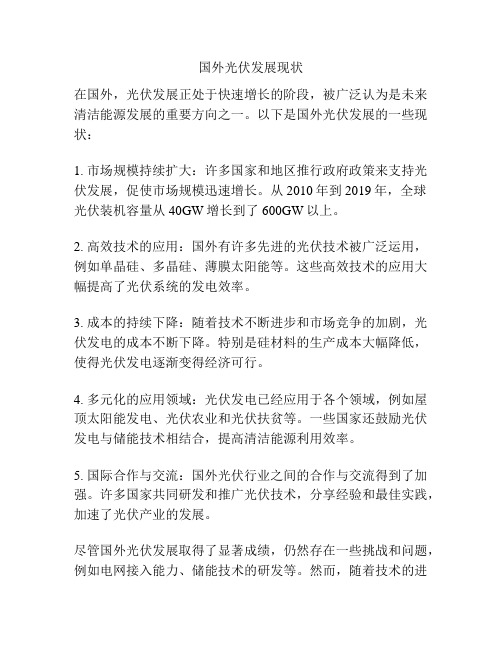
国外光伏发展现状
在国外,光伏发展正处于快速增长的阶段,被广泛认为是未来清洁能源发展的重要方向之一。
以下是国外光伏发展的一些现状:
1. 市场规模持续扩大:许多国家和地区推行政府政策来支持光伏发展,促使市场规模迅速增长。
从2010年到2019年,全球光伏装机容量从40GW增长到了600GW以上。
2. 高效技术的应用:国外有许多先进的光伏技术被广泛运用,例如单晶硅、多晶硅、薄膜太阳能等。
这些高效技术的应用大幅提高了光伏系统的发电效率。
3. 成本的持续下降:随着技术不断进步和市场竞争的加剧,光伏发电的成本不断下降。
特别是硅材料的生产成本大幅降低,使得光伏发电逐渐变得经济可行。
4. 多元化的应用领域:光伏发电已经应用于各个领域,例如屋顶太阳能发电、光伏农业和光伏扶贫等。
一些国家还鼓励光伏发电与储能技术相结合,提高清洁能源利用效率。
5. 国际合作与交流:国外光伏行业之间的合作与交流得到了加强。
许多国家共同研发和推广光伏技术,分享经验和最佳实践,加速了光伏产业的发展。
尽管国外光伏发展取得了显著成绩,仍然存在一些挑战和问题,例如电网接入能力、储能技术的研发等。
然而,随着技术的进
一步成熟和政策的支持,国外光伏发展有望继续保持良好的势头,为清洁能源转型做出更大的贡献。
国外光伏产业发展及其对中国的启示
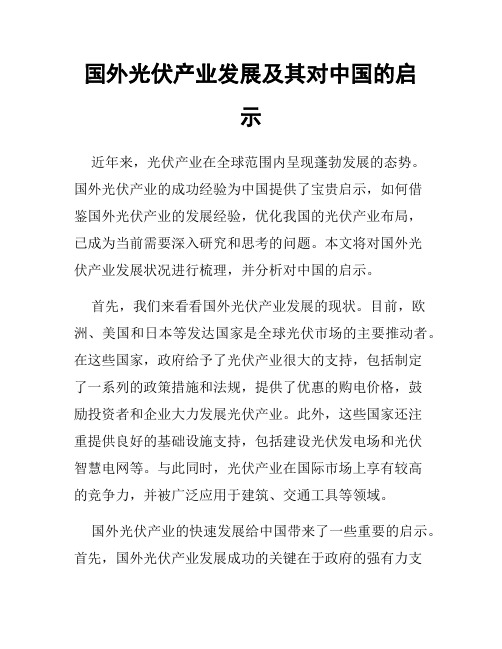
国外光伏产业发展及其对中国的启示近年来,光伏产业在全球范围内呈现蓬勃发展的态势。
国外光伏产业的成功经验为中国提供了宝贵启示,如何借鉴国外光伏产业的发展经验,优化我国的光伏产业布局,已成为当前需要深入研究和思考的问题。
本文将对国外光伏产业发展状况进行梳理,并分析对中国的启示。
首先,我们来看看国外光伏产业发展的现状。
目前,欧洲、美国和日本等发达国家是全球光伏市场的主要推动者。
在这些国家,政府给予了光伏产业很大的支持,包括制定了一系列的政策措施和法规,提供了优惠的购电价格,鼓励投资者和企业大力发展光伏产业。
此外,这些国家还注重提供良好的基础设施支持,包括建设光伏发电场和光伏智慧电网等。
与此同时,光伏产业在国际市场上享有较高的竞争力,并被广泛应用于建筑、交通工具等领域。
国外光伏产业的快速发展给中国带来了一些重要的启示。
首先,国外光伏产业发展成功的关键在于政府的强有力支持。
中国政府应加大对光伏产业的政策扶持力度,制定相关的产业规划和政策,提供必要的财税和金融支持,鼓励企业增加研发投入,培养光伏人才,推动光伏产业的技术创新和转型升级。
其次,国外光伏产业的成功离不开良好的市场开放环境和产业集群效应。
中国应积极引进外资,加强与国外光伏企业的合作交流,提高我国光伏产业的国际竞争力。
此外,加强合理布局,形成光伏产业的集聚效应,有利于提高产业内部的协同创新水平,降低成本,提高效益。
在借鉴国外光伏产业经验的同时,我们也要看到一些问题和挑战。
首先,国外光伏产业的发展多依靠政府强有力的支持和引导,但这也带来了一定的市场风险。
政府补贴政策的变化和调整可能会对光伏市场产生不利影响,因此需要谨慎制定政策和规划,避免出现严重的市场波动。
其次,国外光伏产业发展过程中存在一定的技术壁垒和专利保护问题。
中国光伏企业应加强自主创新能力,加大技术研发投入,建立知识产权保护体系,提升我国光伏产业的核心竞争力。
此外,国际市场竞争激烈,需要提高我国光伏产品的品质和服务水平,打造具有国际竞争力的光伏品牌。
国内外光伏发电发展现状及前景
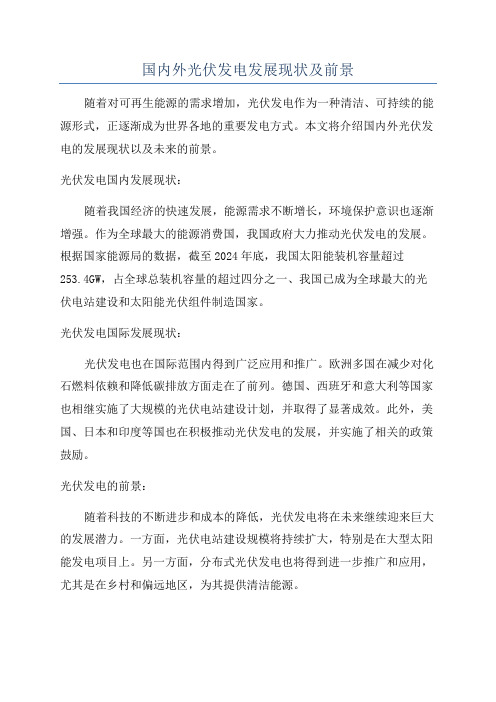
国内外光伏发电发展现状及前景随着对可再生能源的需求增加,光伏发电作为一种清洁、可持续的能源形式,正逐渐成为世界各地的重要发电方式。
本文将介绍国内外光伏发电的发展现状以及未来的前景。
光伏发电国内发展现状:随着我国经济的快速发展,能源需求不断增长,环境保护意识也逐渐增强。
作为全球最大的能源消费国,我国政府大力推动光伏发电的发展。
根据国家能源局的数据,截至2024年底,我国太阳能装机容量超过253.4GW,占全球总装机容量的超过四分之一、我国已成为全球最大的光伏电站建设和太阳能光伏组件制造国家。
光伏发电国际发展现状:光伏发电也在国际范围内得到广泛应用和推广。
欧洲多国在减少对化石燃料依赖和降低碳排放方面走在了前列。
德国、西班牙和意大利等国家也相继实施了大规模的光伏电站建设计划,并取得了显著成效。
此外,美国、日本和印度等国也在积极推动光伏发电的发展,并实施了相关的政策鼓励。
光伏发电的前景:随着科技的不断进步和成本的降低,光伏发电将在未来继续迎来巨大的发展潜力。
一方面,光伏电站建设规模将持续扩大,特别是在大型太阳能发电项目上。
另一方面,分布式光伏发电也将得到进一步推广和应用,尤其是在乡村和偏远地区,为其提供清洁能源。
此外,光伏发电技术的不断创新也将进一步提高光伏发电的效率和可持续发展能力。
例如,高效率太阳能电池技术(如多结太阳能电池、钙钛矿太阳能电池等)已经得到广泛研究和应用。
新材料的开发和新工艺的改进也将进一步降低光伏发电的成本,并提高其性能。
光伏发电的发展还需要政策的支持和市场的推动。
政府应该继续优化光伏发电政策,提供更多的资金和税收支持,鼓励企业和个人投资光伏发电。
此外,随着电动汽车的普及和储能技术的进步,光伏发电与电动汽车、储能系统的结合将为光伏发电创造更多的市场需求。
综上所述,国内外光伏发电在过去几年取得了巨大的发展。
随着技术的进步、成本的降低和政策的支持,光伏发电的前景非常看好。
未来,光伏发电将继续发挥重要作用,为实现能源可持续发展和减少碳排放做出积极贡献。
越南电力现状

500 1559 2700
220 3200 6000
66-110 7500 7050
中压 50500 10400
二、发展规划
据越工业发展计划,2005年越全国总发电量达440-445亿度,平均每年增长将达11-11.3%。届时越全国装机总量将达1140万千瓦,其中水电占40%,燃气机组占44%,燃煤机组占15%,总量将比目前增长520万千瓦。2020年越发电将达1679亿度,在2000年至2020年间,将新建总容量为3000万千瓦的电站,其中水电站1000万千瓦,火电(联合循环和常规火电)约1000万千瓦,燃气煤机组400万千瓦,地热发电10万千瓦,与邻国交换400万千瓦,核电120万千瓦。根据上述计划,2020年装机总量应接近3500万千瓦,其中水电机组占39.7%,燃煤机组占13.9%,进口电力占11.5%,核电和地热发电占3.7%。
(三)用好代理商。好的越方代理在电站项目竞标中起到重要作用,不但可及时通报招标信息,提出投标建议,还可加强中方企业与越客户的联络,协调与业主关系,在招标中发挥影响,提高竞争力。但有的代理在争取项目中作用一般,甚至个别越企业鱼目混珠,以代理之名骗取代理费,要注意甄别,防止上当。
越南电力市场分析
越南市场投资政策 2007-06-11 09:54:02 阅读72 评论0 字号:大中小 订阅
一、发展现状
为实现工业化现代化目标,越政府大力发展电力行业。目前,越南总装机容量576.5万千瓦,实际发电量为538.4万千瓦,其中水电占53%,火电占22%,燃气轮机机组以及柴油发电机组占25%。1999年总发电量为237.39亿千瓦时,其中水电占58.7%,火电占22.7%,燃气及柴油机组占18.6%。1991至1999年间,越发电量年均增长12%,共增长2.5倍。越南水力发电的比例在1991-1996年间高达70%,在1998年下降到51%,1999年由于水量的增加和水利监测的力度加大而有所回升,占到58%。燃气电站,尤其是天然气发电所占的比例持续上升,到1998年接近23%,1999年由于水力发电的比例上升,这一比例下降到18.6%。
越南工程行业发展现状及未来趋势分析

越南工程行业发展现状及未来趋势分析近年来,越南的经济快速增长,其中工程行业在国家发展中扮演着重要的角色。
本文将对越南工程行业的现状进行分析,并探讨该行业未来的发展趋势。
一、越南工程行业的现状分析1. 市场规模扩大:越南工程行业在过去几年中呈现出持续增长的态势。
根据相关数据,越南的GDP中有很大一部分是由工程领域贡献的。
政府的投资政策和基础设施建设项目的推动,使得越南的工程行业市场规模不断扩大。
2. 基础设施建设项目:越南政府一直将基础设施建设作为推动经济增长和吸引外国投资的重点领域。
近年来,越南在能源、道路、铁路、港口等领域进行了大型基础设施建设。
例如,越南在2020年完工了北部高速公路和一条连接中国和越南的铁路项目,这些项目为越南的工程行业提供了巨大的机会。
3. 科技进步和数字化转型:越南工程行业也受益于科技进步和数字化转型的影响。
随着技术的不断提升,越来越多的工程项目采用了先进的建筑和工程技术。
例如,3D打印技术在越南的住宅建设中得到了应用。
此外,越南政府也鼓励企业加快数字化转型,提高生产效率和质量。
4. 劳动力成本优势:越南的劳动力成本相对较低,这使得越南的工程行业在国际市场上具有竞争力。
许多跨国公司将生产和测试工厂设在越南,以利用这一优势。
然而,虽然劳动力成本低廉,但也存在技术人才短缺和技能匹配度不高的问题。
二、越南工程行业的未来趋势分析1. 可再生能源项目:越南政府致力于可再生能源的发展,鼓励增加清洁能源产能。
越南有着丰富的自然资源,并具备发展太阳能和风能等可再生能源的潜力。
因此,预计越南工程行业将继续在可再生能源项目方面取得进展。
2. 城市化和住房建设:随着城市化进程的加速,越南的城市人口不断增长,对住房的需求也随之增加。
未来,越南工程行业将面临更多住房建设项目,包括公共住房和高品质住房的需求。
这将为工程行业带来新的商机和挑战。
3. 数字化工程:越南正朝着数字化转型迈进,工程行业也不例外。
光伏发电国外发展现状
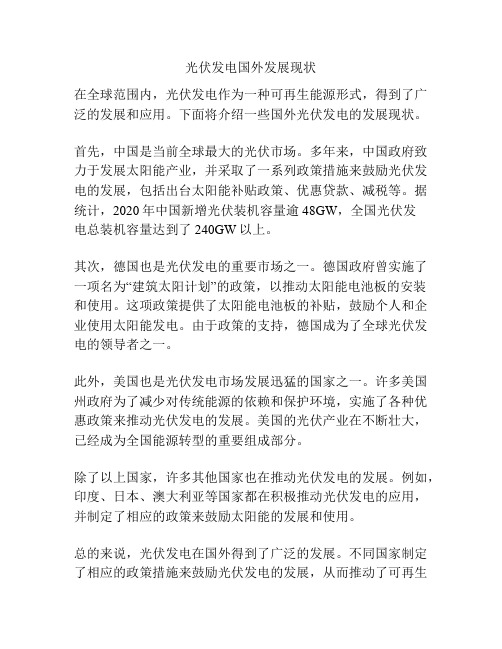
光伏发电国外发展现状
在全球范围内,光伏发电作为一种可再生能源形式,得到了广泛的发展和应用。
下面将介绍一些国外光伏发电的发展现状。
首先,中国是当前全球最大的光伏市场。
多年来,中国政府致力于发展太阳能产业,并采取了一系列政策措施来鼓励光伏发电的发展,包括出台太阳能补贴政策、优惠贷款、减税等。
据统计,2020年中国新增光伏装机容量逾48GW,全国光伏发
电总装机容量达到了240GW以上。
其次,德国也是光伏发电的重要市场之一。
德国政府曾实施了一项名为“建筑太阳计划”的政策,以推动太阳能电池板的安装和使用。
这项政策提供了太阳能电池板的补贴,鼓励个人和企业使用太阳能发电。
由于政策的支持,德国成为了全球光伏发电的领导者之一。
此外,美国也是光伏发电市场发展迅猛的国家之一。
许多美国州政府为了减少对传统能源的依赖和保护环境,实施了各种优惠政策来推动光伏发电的发展。
美国的光伏产业在不断壮大,已经成为全国能源转型的重要组成部分。
除了以上国家,许多其他国家也在推动光伏发电的发展。
例如,印度、日本、澳大利亚等国家都在积极推动光伏发电的应用,并制定了相应的政策来鼓励太阳能的发展和使用。
总的来说,光伏发电在国外得到了广泛的发展。
不同国家制定了相应的政策措施来鼓励光伏发电的发展,从而推动了可再生
能源的利用和环境保护。
随着技术的不断进步和成本的降低,光伏发电有望在全球范围内得到更广泛的应用。
东南亚可再生能源市场的发展现状及前景分析

东南亚可再生能源市场的发展现状及前景分析北极星风力发电网讯:2016 年上半年,东南亚地区电厂级可再生能源项目的发展不再势头强劲。
目前看来,该地区并无计划引入新一轮的上网电价(FiT)补贴,而市场机制也在逐步成型。
虽然短期来看,该地区的项目开发将有所放缓,但随着新项目的经济性不断提高,市场机制开始发挥作用,中期来看,这里的电力市场仍将呈现积极态势。
˙泰国已经进行了第一阶段的社区太阳能(ConmmunitySolar)招标和一轮生物质逆向拍卖,并正在计划第二阶段的招标。
与此同时,泰国的太阳能政策也开始鼓励自给自足式屋顶太阳能系统的普及。
过去,泰国曾讨论过开展新一轮小规模风电逆向拍卖(˙2016年5 月,菲律宾国家可再生能源局(NationalRenewableEnergyBoard)提议引入第三轮上网电价补贴,而能源部(DepartmentofEnergy)也发布了有关实施可再生能源组合标准(RenewablePortfolioStandard,简称RPS)的草案。
不过,由于担心政府补贴会将附加费用进一步转嫁至消费者,菲律宾可能并不会实施第三轮上网电价补贴,除非电价可以达到很低的水平,低至不会给消费者带来额外负担。
˙2016年5 月,马来西亚进行了该国首次电厂级光伏项目招标。
2016 年3 月,越南修正了该国的第7 次电力发展计划,首次制定了明确的太阳能发展目标。
印度尼西亚的新能源发电资源仍主要集中在地热项目,预计将在2016 到2018 年间进行规模高达1625MW 的招投标。
˙2016年上半年,东南亚地区电厂级可再生能源发电项目的融资规模仅为3 亿美元,这预示着这里可再生能源发电项目的增速将在短期内有所放缓。
然而,中期来看,东南亚地区的可再生能源项目仍具有一定潜力。
随着新项目的。
国外光伏产业发展现状

国外光伏产业发展现状近年来,随着经济的快速发展和能源革命的引发,全球光伏发电的应用逐渐展开。
光伏技术的发展使得电力的可再生能源利用率达到了新的高度,这也是经济发展和社会发展的重要内容。
因此,越来越多的人开始关注全球光伏产业的发展现状,并对它未来的发展趋势充满期待。
以下将从技术、市场和规划三个方面,简要介绍国外光伏产业的发展现状。
第一,国外光伏技术的发展取得了很大进步。
目前,光伏领域的主流技术包括太阳能光伏、柔性太阳能光伏、薄膜太阳能光伏、有机太阳能光伏以及太阳能电池等。
这些技术有助于改善光伏发电的效率,节约使用时间和成本,并且可以适应不同的环境和应用需求。
此外,国外也在开发先进的光伏设备,提高光伏设备的可靠性和安全性,使它可以在复杂环境中得到更大的应用。
第二,国外光伏市场正日益发展。
当前,各国政府正大力支持光伏技术的发展,发放各种补贴政策,鼓励企业和个人投资光伏项目。
而且,互联网和新能源技术的发展也给光伏发电带来了强大的推动力,推动国外光伏市场的发展。
此外,国外也利用有效的营销策略,提高消费者对光伏发电的兴趣,例如,鼓励家庭和企业安装光伏电池板,利用光伏发电节省电费等。
第三,国外政府正在大力制定和实施光伏发展规划。
根据市场需求,国外正在推进全球规模的光伏发电建设,例如,美国、俄罗斯、印度等国都在努力实施大规模的光伏发电计划,实现更大规模的利用太阳能发电。
此外,国外还推出了大量的税收政策,给光伏项目投资者带来更多的好处,促进了光伏项目的投资开发。
总之,国外光伏产业发展取得了很大的进步。
技术的发展和政策的制定,使光伏发电在全球范围内得到更多应用,使消费者得到更多的好处。
未来,光伏技术将继续发展与进步,将为人类提供更多的清洁、安全和可再生的能源。
国外分布式光伏发展现状

国外分布式光伏发展现状摘要:一、国外分布式光伏发展现状概述二、国外分布式光伏的发展现状及特点1.德国2.美国3.日本4.印度三、国外分布式光伏发展的政策和措施四、我国分布式光伏发展现状及挑战五、结论与建议正文:一、国外分布式光伏发展现状概述分布式光伏发电是一种新型的能源供应方式,它具有清洁、高效、可持续等特点,是未来能源发展的重要方向。
近年来,国外分布式光伏发电得到了快速发展,很多国家都提出了相应的发展目标和政策措施,大力推动分布式光伏发电的普及和应用。
本文将对国外分布式光伏发展现状进行概述,以期为我国分布式光伏发电的发展提供借鉴和参考。
二、国外分布式光伏的发展现状及特点1.德国德国是全球分布式光伏发电装机容量最大的国家,其发展分布式光伏发电具有以下特点:首先,政策支持力度大,德国政府通过出台一系列政策,如光伏补贴政策、净计量政策等,鼓励居民和企业投资分布式光伏发电系统;其次,技术水平高,德国分布式光伏发电系统在设计、安装、运行等方面均具有较高的技术水平;最后,民众参与度高,德国政府积极鼓励民众参与分布式光伏发电项目,通过自发自用、余电上网等方式,实现能源的高效利用。
2.美国美国分布式光伏发电的发展现状主要表现在以下几个方面:首先,发展速度快,美国分布式光伏发电装机容量逐年快速增长;其次,发展模式多样,美国分布式光伏发电项目既有居民户用系统,也有商业、工业系统,还有微电网、虚拟电厂等创新模式;最后,政策支持力度大,美国政府通过税收抵免、补贴等政策,支持分布式光伏发电的发展。
3.日本日本分布式光伏发电的发展现状主要表现在以下几个方面:首先,政策支持力度大,日本政府通过出台一系列政策,如光伏补贴政策、光伏屋顶计划等,鼓励发展分布式光伏发电;其次,民众参与度高,日本政府鼓励民众通过租赁、众筹等方式参与分布式光伏发电项目;最后,技术水平高,日本分布式光伏发电系统在设计、安装、运行等方面具有较高的技术水平。
太阳能产能最多的五个国家

太阳能产能最多的五个国家目前,中国、美国、欧盟、日本和越南五个国家在太阳能发电方面获得长足发展,已经处于世界领先地位。
这些国家正在向世界证明,太阳能这种可再生能源可以有效替代化石燃料。
1. 中国中国是世界上人口最多、碳足迹占比最高的国家。
中国已发布关于可再生能源的明确承诺,该承诺令人鼓舞。
中国国家能源局数据表明,2020年,中国光伏装机容量超过48吉瓦,总装机容量达到253.6吉瓦。
这一光伏产能足以让中国保持其市场领先地位,中国光伏市场占全球总装机容量市场的33%。
值得注意的是,2017年,中国光伏市场份额达到51%。
此后,各国光伏产能提高,中国的主导地位有所下降。
大多数光伏产品(如太阳能电池板)建设在偏远地区的大型太阳能农场,这些农场利用太阳能发电,再将电力出售给公共事业公司。
卫星图像显示,中国各地以惊人的速度出现类似规模的太阳能发电厂。
太阳能农场的急剧增长表明,中国对电力需求变大,且对抗空气污染刻不容缓。
如今,一些国家正在实施奖励措施,限制安装太阳能板;而中国政府正积极鼓励安装太阳能电池板,并设置奖励措施。
2. 美国美国通过发展电力部门,鼓励居民安装太阳能板,不断提高其在太阳能领域的领导地位。
太阳能发电增多,在很大程度上,要归功于政府对住宅安装太阳能板的刺激政策,这是一个极富潜力、且增长迅速的领域。
2020年,住宅市场和公共事业部门分别同比增长15%和37%。
2020年,美国新增总装机容量为19.7吉瓦,累计装机容量95吉瓦。
随着太阳能成本的降低,不可再生能源竞争力减弱,美国太阳能产量预计将在未来几年继续增长。
3. 印度印度在太阳能光伏产能领域同样处于世界领先地位。
经过几年的持续努力,2019年,印度光伏市场实现显著增长,占全球光伏市场的9%。
这一份额已经超过了日本(6.3%),且紧追美国(11.9%)。
2022年,印度大部分装机容量由印度公共事业公司实现,在新增装机容量中占比较大。
截至2019年底,该国累计装机容量约为42.9吉瓦。
定了!越南正式出台太阳能发电收购电价
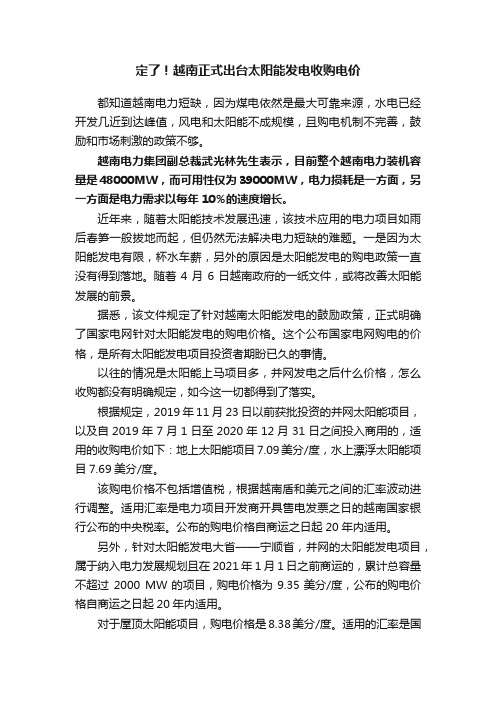
定了!越南正式出台太阳能发电收购电价都知道越南电力短缺,因为煤电依然是最大可靠来源,水电已经开发几近到达峰值,风电和太阳能不成规模,且购电机制不完善,鼓励和市场刺激的政策不够。
越南电力集团副总裁武光林先生表示,目前整个越南电力装机容量是48000MW,而可用性仅为39000MW,电力损耗是一方面,另一方面是电力需求以每年10%的速度增长。
近年来,随着太阳能技术发展迅速,该技术应用的电力项目如雨后春笋一般拔地而起,但仍然无法解决电力短缺的难题。
一是因为太阳能发电有限,杯水车薪,另外的原因是太阳能发电的购电政策一直没有得到落地。
随着4月6日越南政府的一纸文件,或将改善太阳能发展的前景。
据悉,该文件规定了针对越南太阳能发电的鼓励政策,正式明确了国家电网针对太阳能发电的购电价格。
这个公布国家电网购电的价格,是所有太阳能发电项目投资者期盼已久的事情。
以往的情况是太阳能上马项目多,并网发电之后什么价格,怎么收购都没有明确规定,如今这一切都得到了落实。
根据规定,2019年11月23日以前获批投资的并网太阳能项目,以及自2019年7月1日至2020年12月31日之间投入商用的,适用的收购电价如下:地上太阳能项目7.09美分/度,水上漂浮太阳能项目7.69美分/度。
该购电价格不包括增值税,根据越南盾和美元之间的汇率波动进行调整。
适用汇率是电力项目开发商开具售电发票之日的越南国家银行公布的中央税率。
公布的购电价格自商运之日起20年内适用。
另外,针对太阳能发电大省——宁顺省,并网的太阳能发电项目,属于纳入电力发展规划且在2021年1月1日之前商运的,累计总容量不超过2000 MW的项目,购电价格为9.35美分/度,公布的购电价格自商运之日起20年内适用。
对于屋顶太阳能项目,购电价格是8.38美分/度。
适用的汇率是国家银行在上一年最后一天宣布的中央汇率,用于计算下一年支付的电费。
屋顶太阳能项目的购电价格,适用于在2019年7月1日至2020年12月31日期间投运及记录电表数据的项目,价格适用时间是20年。
越南碳中和目标

越南碳中和目标
越南政府已制定碳中和目标,旨在减少温室气体排放并应对气候变化。
以下是越南碳中和目标的简要概述:
1.减少温室气体排放:越南致力于减少温室气体排放,并制
定了一系列政策和措施来实现这一目标。
主要措施包括改善能源效率、推广可再生能源的使用、提高工业和农业部门的排放标准等。
2.发展清洁能源:越南计划在能源领域加大清洁能源的开发
和利用,包括太阳能、风能和生物能等。
这将有助于减少对化石燃料的依赖,降低温室气体的排放。
3.森林保护和恢复:越南计划将森林保护和恢复作为降低碳
排放的重要手段。
他们致力于通过加强森林保护、植树造林和森林管理来增加碳汇。
4.推广电动交通工具:越南将推广电动交通工具和促进绿色
交通系统的发展。
这将减少交通行业的碳排放,降低城市污染和噪音。
5.国际合作和支持:越南将积极寻求国际合作和支持,包括
技术转让、资金援助和知识共享等方面,以实现碳中和目标。
越南的碳中和目标是在2050年实现碳中和。
目前,越南正在采取一系列措施,包括减少温室气体排放、发展可再生能源、提高能源效率等,以努力实现这一目标。
此外,越南政府还计划
促进数字化转型、增强创新能力、加大对医疗保健和文化教育的投入,以实现社会经济步入“人人参与受益、绿色包容增长”的良性轨道。
太阳能光伏发电在全球的发展现状和未来趋势分析
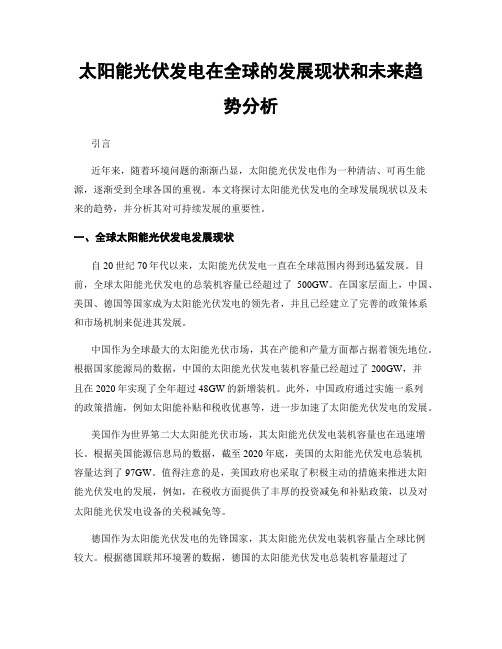
太阳能光伏发电在全球的发展现状和未来趋势分析引言近年来,随着环境问题的渐渐凸显,太阳能光伏发电作为一种清洁、可再生能源,逐渐受到全球各国的重视。
本文将探讨太阳能光伏发电的全球发展现状以及未来的趋势,并分析其对可持续发展的重要性。
一、全球太阳能光伏发电发展现状自20世纪70年代以来,太阳能光伏发电一直在全球范围内得到迅猛发展。
目前,全球太阳能光伏发电的总装机容量已经超过了500GW。
在国家层面上,中国、美国、德国等国家成为太阳能光伏发电的领先者,并且已经建立了完善的政策体系和市场机制来促进其发展。
中国作为全球最大的太阳能光伏市场,其在产能和产量方面都占据着领先地位。
根据国家能源局的数据,中国的太阳能光伏发电装机容量已经超过了200GW,并且在2020年实现了全年超过48GW的新增装机。
此外,中国政府通过实施一系列的政策措施,例如太阳能补贴和税收优惠等,进一步加速了太阳能光伏发电的发展。
美国作为世界第二大太阳能光伏市场,其太阳能光伏发电装机容量也在迅速增长。
根据美国能源信息局的数据,截至2020年底,美国的太阳能光伏发电总装机容量达到了97GW。
值得注意的是,美国政府也采取了积极主动的措施来推进太阳能光伏发电的发展,例如,在税收方面提供了丰厚的投资减免和补贴政策,以及对太阳能光伏发电设备的关税减免等。
德国作为太阳能光伏发电的先锋国家,其太阳能光伏发电装机容量占全球比例较大。
根据德国联邦环境署的数据,德国的太阳能光伏发电总装机容量超过了52GW。
然而,近年来德国的太阳能光伏发电发展进入了一个相对平稳的阶段,主要原因是德国政府逐步减少太阳能光伏发电补贴政策。
二、未来趋势分析1. 价格下降与技术进步随着太阳能光伏发电技术的不断改进与成熟,其成本逐渐降低。
根据国际能源署的预测,到2030年,太阳能光伏发电的成本将比传统能源更低廉,这将进一步推动太阳能光伏发电的普及和应用。
另外,科技的不断进步也将推动太阳能光伏发电技术的突破,比如高效光伏电池的研发和使用,以及能量存储技术的发展等。
光伏龙头股在越南建厂(完整版)

光伏龙头股在越南建厂(完整版)光伏龙头股在越南建厂很抱歉,我不太清楚光伏龙头股在越南建厂的相关信息,不过我可以给你一些其他相关信息。
2023年1月29日,中国光伏组件龙头企业晶澳科技股份有限公司在越南平阳省举行了越南平阳太阳能电池片工厂(以下简称“越南工厂”)投产仪式。
晶澳科技越南平阳太阳能电池片工厂是晶澳科技首个海外生产基地,此次越南工厂的投产标志着晶澳科技在海外市场的战略布局取得了重要进展。
建筑装饰光伏龙头股建筑装饰光伏概念股有:__云南能投。
__宏润建设。
__江河集团。
__东方雨虹。
__亚厦股份。
__兔宝宝。
__华脉科技。
__通光线缆。
__翠屏城。
__罗普斯金。
____ST天龙。
__旗滨集团。
__华平股份。
__艾华集团。
__广田集团。
__凯迪生态。
____ST商城。
__威华股份。
__同力日升。
____ST中天。
以上这些公司,请根据您的需求和风险承受能力进行选择。
需要注意的是,投资有风险,投资需谨慎。
光伏制氢新疆龙头股以下是光伏制氢新疆龙头股:1.青松建化:青松建化主要从事水泥、建材、化工产品的制造和国内外贸易。
公司拥有200MW光伏电站,200MW光伏发电和200MW碱性水电站。
2.新疆大全:公司是全球单体容量最大的盐穴压缩空气储能示范项目开发者,该项目总投入约12亿元,由大全能源董事长李瑶良创办的新疆大全能源有限公司投资。
希望以上信息能够帮助您了解光伏制氢新疆龙头股,注意投资风险。
光伏屋顶设备龙头股光伏屋顶设备领域的龙头股有:1.皇氏集团:在光伏屋顶领域,皇氏集团在安徽滁州投建了全球最大的单体光伏屋顶电站,装机容量为50MW。
2.亚玛顿:公司新成立子公司浙江亚玛顿光伏科技有限公司,布局光伏太阳能领域。
3.东方日升:一直致力于发展太阳能光伏产业,其中就包括分布式电站。
4.鹿山新材:公司积极参加新型城镇化建设,在公共建筑和居民屋顶分布式光伏开发利用等方面具有天然优势。
5.杰恩设计:在光伏电站设计领域,杰恩设计已经形成了成熟的产品和服务体系。
国外光伏发展现状
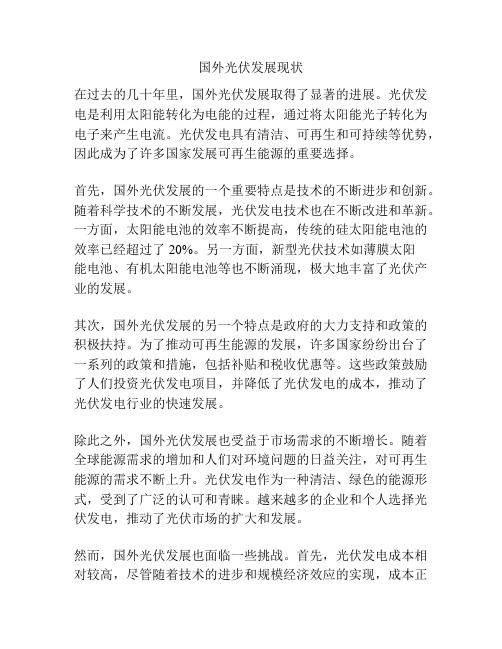
国外光伏发展现状在过去的几十年里,国外光伏发展取得了显著的进展。
光伏发电是利用太阳能转化为电能的过程,通过将太阳能光子转化为电子来产生电流。
光伏发电具有清洁、可再生和可持续等优势,因此成为了许多国家发展可再生能源的重要选择。
首先,国外光伏发展的一个重要特点是技术的不断进步和创新。
随着科学技术的不断发展,光伏发电技术也在不断改进和革新。
一方面,太阳能电池的效率不断提高,传统的硅太阳能电池的效率已经超过了20%。
另一方面,新型光伏技术如薄膜太阳能电池、有机太阳能电池等也不断涌现,极大地丰富了光伏产业的发展。
其次,国外光伏发展的另一个特点是政府的大力支持和政策的积极扶持。
为了推动可再生能源的发展,许多国家纷纷出台了一系列的政策和措施,包括补贴和税收优惠等。
这些政策鼓励了人们投资光伏发电项目,并降低了光伏发电的成本,推动了光伏发电行业的快速发展。
除此之外,国外光伏发展也受益于市场需求的不断增长。
随着全球能源需求的增加和人们对环境问题的日益关注,对可再生能源的需求不断上升。
光伏发电作为一种清洁、绿色的能源形式,受到了广泛的认可和青睐。
越来越多的企业和个人选择光伏发电,推动了光伏市场的扩大和发展。
然而,国外光伏发展也面临一些挑战。
首先,光伏发电成本相对较高,尽管随着技术的进步和规模经济效应的实现,成本正在逐步下降。
其次,光伏发电的可靠性和稳定性仍然存在一定的问题,特别是在夜晚和低光照条件下,光伏发电效果较差。
最后,光伏发电的电网接入和储能技术仍然需要进一步完善,以确保光伏发电能够稳定地供电。
综上所述,国外光伏发展在技术进步、政府支持和市场需求等方面取得了显著的成就。
然而,仍然需要解决一些问题和挑战,才能实现光伏发电的广泛应用和推广。
相信随着科技的不断创新和发展,光伏发电在未来会取得更加辉煌的发展。
- 1、下载文档前请自行甄别文档内容的完整性,平台不提供额外的编辑、内容补充、找答案等附加服务。
- 2、"仅部分预览"的文档,不可在线预览部分如存在完整性等问题,可反馈申请退款(可完整预览的文档不适用该条件!)。
- 3、如文档侵犯您的权益,请联系客服反馈,我们会尽快为您处理(人工客服工作时间:9:00-18:30)。
TECH MONITOR z Nov-Dec 200929Photovoltaic technology and solar energydevelopment in Viet NamTrinh Qung DungViet Nam has potential solar energy for sustainable development. The year-round high solar radiation of 5.2 kWh/m 2 per day is a basic factor to develop solar electricity on an industrial scale for Viet Nam. New technologies not only allow solar electricity produced to be fed to the grid, but also guarantee sustainable local power supply at low prices. In the face of increasing demand and market for power, exploitation of Viet Nam’ renewable energy sources is very urgent. A mega solar programme for long-term sustainable energy development is under preparation, and it will be submitted for the government’s approval,after discussion in a Joint Ministerial Meeting.Solar radiation in Viet Namolar radiation is a very important natural resource in Viet Nam. At an average total solar radiation of about 5 kW/h/m 2/day in most of the middle and the southern provinces and about 4 kW/h/m 2/day in the north-ern provinces, solar radiation is better in Viet Nam than in most other parts of the world (Dung, 2005). Below the 17th parallel, the radiation is not only plentiful but also steady for most part of the year, reducing about 20 per cent from dry season to rainy season.1 The solar energy potential is estimated at 43.9 billon tonnes of oil equivalent(TOE) per year. Figure 1 shows the average total solar radiation in Hanoi,Danang and Ho Chi Minh (HCM) city,which are typical for the northern, mid-dle and southern regions of Viet Nam.The average solar radiation is better in the middle and southern regions.The northern provinces receive poor sunshine in the first quarter of the year;there are only two hours or less of sun-shine during January, February and March and the average solar radiation is 50-60 per cent less. The average sunshine hours per year in the North-eastern zone range between 1,500and 1,700 hours, while the Southern and Central Viet Nam clocks between 2,000 and 2,600 sunshine hours per year. These data, measured over a period of 10 years, were taken from the weather station at HCM City.1In North Viet Nam, the solar radiation is not continuous in winter and autumn.SMr. Trinh Qung Dung Director, Solarlab-Institute ofPhysics, HCM CityVietnamese Academy of Scienceand Technology01 Mac Dinh Chi Street, 01 District,HCM City, Viet Nam Tel: +84 (8) 3822 2028Fax: +84 (8) 3829 5905E-mails:trinhqdungvn@solarlab@nam.vn30TECH MONITOR z Nov-Dec 2009Renewable energy status and development needPresent situationA general view of the development of photovoltaic (PV) installations in Viet Nam in the last decade can be seen in Figure 2 and Table 1. PV develop-ment has been realized in applications such as battery charging centre, com-munity centre, telecommunications,satellite receiver-transmitter, naviga-tion beacons, etc.Following several national and in-ternational projects, most of the civil use of PV is in solar villages, which have in solar home systems (SHS),covered community centres, battery charging centres (BCC), cultural halls,schools, medical centres, etc. Almost all models of PV applications – suchas SHS, BCC, medical and commu-nity centres, solar ambulance, satel-lite receiver-transmitter, etc. – have been designed and developed in Viet Nam. During 20 years of development,about 70 solar villages, 30 BCCs,thousands of navigation beacons,several telecommunication stations and more than 4,000 SHS have been installed across the country.Among civil applications, SHS is the most basic; it started in 1990 and gradually developed. Its growth is spurred by government-sponsored PV projects as well as private installa-tions (Dung, 2008). The demand for SHS is very large, covering over 5million farming families, which could not be connected to the grid for a long time. An SHS project was the first 100per cent electrified village in Viet Nam,in Buon Cham, wherein 180 familieswere provided solar electricity at their homes (Dung, 2003). The cultural-cum-battery charging centre (CBCC)is a typical Vietnamese innovation,which has shown 20 per cent more efficiency than other similar installa-tions in the region. Each CBCC is de-signed to produce 300-1,500 Wp per station, and a 1,000 Wp CBCC can provide electricity for 40-50 houses.From 1990 up to the present, more than 1,000 families have started using solar electricity from the CBCC. In the night, a CBCC doubles as a local cultural centre for viewing television programmes and video movies, and for Karaoke singing. This is a new and highly effective model of PV use invented by Viet Nam’s Solarlab (Dung and others, 2003).In 1999, thanks to the cooperation between New Energy and Industrial Technology Development Organiza-tion (NEDO) of Japan and the Ministry of Science, Technology and Environ-ment (MOSTE) of Viet Nam, the first solar power plant was installed at the Muang Giang district of Gialai pro-vince in Central Viet Nam. The plant is a hybrid renewable energy model,with 100 kWp of solar power and 25kW of micro hydropower. It is the first solar plant in Viet Nam and South-East Asia working for a local grid. The big-gest solar installation is the National Conference Hall, with 154 kWp of solar power using grid-connected technol-ogy, financed by Germany’s official development assistance (ODA). Red Sun, the first factory to manufacture PV modules, was opened in March 2009 at Long An province. Its annual capacity is about 3-5 MWp. Only five companies in Viet Nam are doing busi-ness in the PV field: too meagre a number considering the solar energy potential of the country.The main Vietnamese partners for international collaboration until now are Solarlab, Institute of Energy (IE),Renewable Energy Research Centre (RERC) and Women’s Union. Coop-eration has been established with NEDO of Japan, Fondation Energies pour le Monde (FONDEM) of France,Swedish International Development Cooperation Agency (SIDA), Nord-rhein-Westfalen (NRW) of Germany,Solar Electric Light Fund (SELF) ofFigure 1: Solar radiation in the north, middle and south of Viet Nam10234567123456789101112MonthsS o l a r r a d i a t i o n (k W h /m 2/d a y )Ho Chi Minh city Hanoi DanangFigure 2: Development of photovoltaics in Viet Nam (1989-2008)P h o t o v o l t a i c c a p a c i t y (k W p )408012016024019892001991199319951997199920012003200520071990199219941996199820002002200420062008YearsTECH MONITOR z Nov-Dec 200931the United States, Korea Institute of Energy Research (KIER) of the Repub-lic of Korea, Atersa of Spain, and some other institutions from the European Union countries. Total international investment on PV in Viet Nam was about US$50 million (Table 2). Inter-national cooperation has been a major catalyst, spurring renewable energy development, promoting local technol-ogy and building up human resource skills in Viet Nam. The Government of Viet Nam has always provided budg-etary support of up to 30 per cent for such cooperation activities.Government policy and Master Plan VIA government policy on renewable energy is taking shape in Viet Nam at present. The government plans to increase budget for renewable energy projects in rural areas and establish a renewable energy fund for invest-ment support. It is already supportingPV research at the Semiconductor-Nano Laboratory in the high-tech park at HCM city (US$11 million) and the semiconductor laboratory of the Na-tional University (US$5 million). The government supports transfer of the latest PV technologies to Viet Nam,and encourages foreign investment for local PV manufacture.At the present, import is duty-free for solar modules and for all solar pro-jects. The government is encouraging banks to provide investment capital for PV industries. On other hand, the government has decided to use ODA fund for developing grid-connected solar plant and large solar power projects. During 2009-2012 about 3-5 MWp of PV power will be added using ODA from Japan. In July 2007,the Vietnamese government approved Master Plan VI, which envisages rural electrification using renewable energy.Viet Nam generates 68,699 GWh of electricity and consumes 57,366Year Photovoltaic applicationNumberInstalled Total capacitycapacity (Wp)(KWp)1989-2008Solar home system 4,00022-100314,0101989-2008Public systems 152100-30030,3941989-2008Medical centre24150-3003,4501990-2008Telecommunication systems 2,000500-3,0001,000,0001996-2000Radio telephone 275-1000,1751995-2008Forest guard station90100-1,00032,0001989-2008Cultural & battery charging centre 80300-3,20052,0001990-2008Navigation beacon 1,30050-15045,0001995-2008Satellite receiver 50500-4,000100,0002000-2003Solar boat 2250-6400,8902002-2006Solar power plant 2100-154254,0002005-2008Solar villa/house roof 71,000-4,00011,2001999-2008Solar school 23200-1,00012,2501989-2008Street lamps 20050-16050,0002001Solar ambulance 15000,5001990-2008Water pumping 3100-5001,9001989-2008National park 12200-1,0005,0001989-2008Solar lantern 4210-2003,3.562004-2008Public lighting 10050-2008,000TOTAL8,0902,407,175Table 1: Development of photovoltaic applications in Viet NamSource: Dung, 2009aCultural-cum-battery charging centreSolar ambulance32TECH MONITOR z Nov-Dec 2009GWh annually. The growth in the rate of consumption is about 15-20 per cent per year and the country will need to import energy beyond 2010(Figure 3). The energy sharing pat-tern is: industry 49.9 per cent; civil and services 41.0 per cent; agricul-ture 0.97 per cent; and others 9.0 per cent.According the Master Plan VI, re-newable energy in Viet Nam is envi-sioned to develop in two stages to reach the total of 4,050 MW by 2025:2015 MW during the period 2006-2015; and 2026 MW during the period 2015-2020. Rural households are expected to be electrified by 2020using renewable energy sources.Photovoltaic project Sponsor Implementing Budget (US$)Years organization Energy solidarity Fondem, France &Solarlab 1,000,0001989-2000Vietnam - FranceDostes, Viet Nam Solar lighting for Women by SHS SELF, United States Wu - Solarlab 150,0001995-1998RET’s PV ProjectSIDA, Sweden Solarlab 170,0001997-2004RET’s Biomass Briquetting SIDA, Sweden IE170,0001997-2004Solar Hybrid Plant NEDO, Japan &Fuji Electric 3,500,0001999-2002MOST, Viet Nam Decentralized Energy for Fondem, France &Solarlab 1,200,0002000-2003Rural Development DI, Viet Nam Solar Electricity NRW, Germany &Solarlab, RERC 200,0002001-2002Viet Nam-GermanyMOSTE, Viet Nam Solar VillageKIER, Rep. of Korea Solarlab 80,0002002-2005Viet Nam-Republic of Korea & Solarlab, Viet Nam National Conference Hall Viet Nam & Germany Lilama2,000,000 -2006Rural electrification SIDA, Sweden &Ha giang, Quang Nam unknown 2005-2008MOIT, Viet Nam provinces Semiconductor Lab National University,University of 5,000,0002004-2006HCM City Natural Science Semiconductor Nano-Lab HCM City High Tech Park 11,000,0002006-2008Rural electrificationAtersa, Spain &Solarlab-VAST 200,0002006-2009MOST, Viet Nam PV plant 28 KWp at Cham island SIDA, Sweden &DOIT,600,0002008-2010MOIT, Viet Nam Quang Nam province Grid-connected PV Japan’s ODA Japanese companies 15,000,0002009-2010Others CDG, CORE,Solarlab, IE, RERC,3,200,0001995-2010World Bank, etc.CODEV, etc.TOTAL50,000,0001989-2010Collected by Solarlab from different sources (2009)Table 2: International projects and total investments on PV in Viet NamFigure 3: The structure of energy balance of Viet Nam by 201528.5%32.0%31.6%4.9% 3.0%Hydro powerThermal powerGas powerRenewable energyImported electricityPhotovoltaic technology in Viet NamSince 1975, PV has been studied at the Centre of Physics, HCM City, of the Viet Nam Academy of Science. The first solar cell was made in 1976 on monosilicon crystal of 5 cm diameter. During 20 years of research, different types of solar cells – such as thin film solar cell, mono-silicon solar cell (η=13 per cent), polysilicon solar cell (η = 12 per cent) and amorphous sili-con solar cell (η = 7 per cent) – have been developed at Solarlab, the Viet Nam Academy of Science & Technol-ogy. In 2000, the first prototype solar module has been developed to inter-national quality standard (Dung, 2005). PV energy saving technology A photovoltaic energy saving technol-ogy (PVEST) has been researched and developed for improving the ef-ficiency of PV systems (Dung, 2008). All kinds of PV equipment – such as solar regulator, true sine inverter and DC compact energy-saving lamps –have been manufactured in Viet Nam. Except for the solar module, 80 per cent of PV equipment are provided by local manufacturers. Most of them still follow analog technology, with only a small part utilizing digital tech-nology for monitoring and manage-ment systems.True sine inverters up to 10 kVA and solar chargers with 10-12 chan-nels have been developed. In a joint venture with SPI GmbH of Germany,solar generators have been manu-factured under the brand of ‘SmartGreen Power’ and exported to Africa,Europe, Iran, etc. In general, the PVequipment technology is well devel-oped in Viet Nam, and it can well servethe domestic market with competitiveprice and quality. Three years ago,Solarlab had successfully designedMadicub, an integrated solar-local gridmanaging system suitable for expand-ing PV power anywhere, any time. Thismode is being further developed forrural electrification, as a “mini solarpower plant”, in the range of a fewkWp up to little less than 100 kWp.Figure 4 shows the block diagram.The integrated system is designedon the basis of hybrid technology,which is flexible and easily modifiedto meet local conditions in differentconfigurations, as follows:For mountainous area: Solar energy+ micro-hydro energy/MadicubFor coastal and island area: Solarenergy + wind energy/MadicubFor inland area: Solar energy + Dieselgenerator or biomass energy/MadicubFor towns and cities: Solar energy +power grid/MadicubMadicub is available from 1 kVA to10 kVA – basic for a solar array of avariable power range between 500 Wpand 10 kWp.The development of DC compactenergy saving lamp (CESL) was beenin 2000. While the cost of this lampis slightly higher than the traditionalfluorescent lamp, the advantages itoffers are enormous. It has about 10times higher lifetime, bright and softlight, and consumes much less powerthan traditional lamps. The last fea-ture allows the use of more CESLsthan the fluorescent lamps with asimilar PV system. CESL lamps arealso aesthetically pleasing. It is a verypopular accessory for PV develop-ment. The 12 Vdc CESL saves 70 percent energy, helping to reduce thecost of an SHS by 5-10 per cent in VietNam. Adaptive research on CESL wascompleted under the RET project andpilot manufacturing is in the offing.However, as CESLs are less energy-saving than LEDs and harmful to theenvironment, they are being gradu-ally limited. The popularity of LEDlighting is growing fast in Viet Nam,and it features in CDM project, solarstreet lamps and “fish luring LED”.Smart IntegratingPV Technology (SIPV)The Smart Integrating PV Technology(SIPV) is a complete solution for grid-connected renewable energy sourcesand does not waste any electricitygenerated from renewable energysources (Dung, 2009b). It is veryefficient in its usage of PV and otherrenewable energy sources, and isuseful against black out and duringerratic grid power supply as well. Theblock scheme of SIPV is presentedin Figure 5. All local renewable energysources, mainly a PV array, could beused to feed the local network withelectricity. The shortfall in the energy Figure 4: The block diagram for MadicubRural electricityEnergy securityWindGridDiesel generatorHydroelectricStandby equipmentSupport gridContinuous sourceCheap grid power priceTECH MONITOR z Nov-Dec 200933supply will be drawn from the grid auto-matically. When the power from PV array is inadequate, a battery bank will kick in to prevent black out. Similarly, when the grid is off and solar power is insufficient, Madicub will switch over (switching time 30 ms) to battery mode and supply power to the local network. This operation will also commence when the battery bank is too full and needs to be partially discharged.When the solar electricity load is above 10 per cent of the set value, the PV Madicub (true sine; standard fre-quency ±1 per cent) will automatically switch off partly to regulate power supply to the local network. The addi-tional solar electricity generated will be used to charge the battery bank for energy storage.The system helps reduce expense towards power purchase by tapping grid electricity only from 22:00 PM to 04:00 AM.2 The grid-charger is pro-grammed to jump in to buy power for charging battery bank for storage, and use that power in peak times when grid power is at the highest price. SIPV works in fully automatic mode and all operations are monitored and man-aged. The SIPV technology won the Gold Cup at the Asia Tech-Mart Plus3 (Asian countries plus Japan, Chinaand the Republic of Korea) in 2009.The first solar roof (12.6 kWp) usingSIPV technology has been displayedby Solarlab and Tuan An Group atTuan An headquarters in HCM City.Mega Solar Programme2010-2025Solar electricity industry is expandingaround the world. It has several ad-vantages over other energy sources:it is endless and clean, and has nowaste, noise or negative environmen-tal impact. It is expected to be thenumber one energy source by 2100,meeting up to 75 per cent of the globalenergy demand (Dung, 2009c).ObjectivesThe demand and market for renew-able energy exploitation in Viet Namis very high and urgent, as reflectedin Master Plan VI. In recognition ofthis, a Mega Solar Programme (MSP)is under preparation for discussionin a Joint Ministerial Meeting beforesubmission for government approval.MSP has the following main goals:z Increase the competitiveness ofViet Nam’s solar electricity indus-try to world level by 2025;z Raise the country’s position in theregion to the top in PV technologydevelopment and PV productioncapacity;z Effectively exploit solar electricityto secure national energy supply,and national socio-economic dev-elopment in general, by providingthe country 250 MWp, which isequivalent to 1.25 billion kWh/dayor 456.25 billion kWh/year by 2025;z Decrease the price of solar elec-tricity by 30 per cent by 2015, andto the level of the price of tradition-al electricity by 2040; andz Ensure that the national grid, in-cluding solar electricity, will fullyelectrify the entire country by 2025.Programme contentMSP will be implemented with the co-operation of both public and privatesectors. Three groups of projects areplanned as the following:A. Public welfare projects: This groupof projects will play a crucial role inpushing the development of solarelectricity in Viet Nam. It will establishsolar electricity projects and collectreliable data on the development pro-cesses and for proof of solar energypotential. The data will be submittedto the government in order to improvethe legal foundation – by way of poli-cies, regulations and legislations –to promote research, investment andmanufacture of solar energy.B. Core technologies projects: Thisgroup of projects aims to develop VietNam’s photovoltaic industry to worldlevel.C. Fiscal stimulus projects: This groupof projects, which will be tied to theoutput of the core technologies pro-jects, are investment projects for theconstruction of establishments thatuse solar electricity.Kim Dinh International Group JointStock Company, Tuan An Group JointStock Company and many other localcompanies in the energy businessare very interested in participating inthe development of solar electricity.The private sector is looking forwardto a long-term, comprehensive nation-al solar energy programme. Four bigprojects have been already plannedand are awaiting macro policy supportFigure 5: The block scheme of SIPV 2 Electricity Viet Nam’s tariff is the lowestfrom 22:00 PM to 04:00 AM.34TECH MONITOR z Nov-Dec 2009TECH MONITOR z Nov-Dec 200935from the government: 10,000 solar roof project (Tuan An Group); 2 MWp local,grid-connected solar plant project (Tuan An Group); 10,000 solar and renewable energy public lighting pro-jects (Kim Dinh International Group);and renewable energy demonstration park project. Besides these, two core technologies projects have also been planned: project for building a factory to produce 15 MW/year of solar cells and solar modules (Tan Hiep Phuc Joint Stock Company), project for building a factory to produce 10 kW and 25 kW solar thermal parabolic dishes using Stirling technology [co-operation between Germany’s Stirling Sun Power International GmbH (SSPI)and three Viet Nam companies].Solar roof projectPotential investors: Tuan An Group Joint Stock company and Viglacera Group.Details: 10,000 solar roofs from 1 kWp to 100 kWp, using SIPV technology with total capacity of 10 MWp will be built across the country. The project aims to effectively use solar electricity to balance the national grid supply in urban areas and to electrify remote inland/island/border areas. This pro-ject will lay a foundation for the devel-opment of solar electricity in Viet Nam.Technologies and human resource for solar industry will be also devel-oped through the project.Renewable energy public lighting projectPotential investors: Kim Dinh Interna-tional Group Joint Stock Company Details: Public lighting shares a big portion in the national energy balance.However, the existing public lighting systems in Viet Nam are obsolete, and cause enormous energy loss. Thenew public lighting project goal is to produce and install 10,000 efficient lighting systems using light emitting diode (LED) and high intensity dis-charge (HID) technologies, which may save up to 70 per cent of energy, to replace the existing high voltage light bulb systems, and employ renewable electricity source instead of grid for public lighting. Besides supplying for the local market, the project also looks forward to exporting to international market. Kim Dinh International Group has plans to build a high-tech factory for manufacturing lighting devices.With 10,000 new public light systems to be installed across the country, the initiative will be a full-scale demon-stration project for renewable energy.Local grid-connected solar plant projectPotential investors: Tuan An Group Joint Stock company, ODA capital from Spain and othersDetails: This project will build the first local grid-connected solar plant on a remote island of Viet Nam. It will lay the foundation for exploiting solar energy to support coastal and remote island communities, and in supporting na-tional security and defence capability.Manufacturing accessory devices projectPotential investors: Tuan An Group Joint Stock companyDetails: With technology transferred from Germany, Tuan An Group will con-struct a factory in Long An province for manufacturing smart PV devices.The factory will produce devices and equipment for solar industry such assolar chargers and solar inverters. At the first step, this factory will provide devices for a 2 MW grid-connected local solar plant. In the long run, the factory is expected to produce high quality PV devices for local market and gradually extend to international market.Manufacturing solar cells and solar modules projectPotential investors: The General De-partment of Defence Industry, Tan Hiep Phuc Joint Stock companyDetails: Tan Hiep Phuc has brought out a feasibility study report for a pro-ject to build a factory with capacity of 15 MW per year solar cells and solar modules. The project is seeking for cooperation with Taiwanese compa-nies and other local companies.Renewable energy demonstration park projectPotential investors: RCEEDetails: This project will build a dem-onstration park to demonstrate all kind of renewable energies in the “World Biosphere” area Can Gio, HCM city. In the park, the most advanced technol-ogies in renewable energy industry will be demonstrated. Besides a 200kWp solar farm, wind, biogas and bio-mass farms are also planned to be built.Electric and solar taxi project Potential investors: Mai Linh Energy Joint Stock CompanyDetails: Mai Linh has brought out a feasibility study report about using electric taxies in Lao Bao Special Eco-nomic Zone of Quang Tri province. The company is working to transfer the technology into Viet Nam. The success of this project will be a starting point for using electric cars in ecotourism zones, export processing zones, in-dustrial zones, etc.Manufacturing solar thermal para-bolic dishes projectPotential investors: SSPI, Germany,and 3 local companiesDetails: The project is about building a factory to produce 10 kW and 25 kW solar thermal parabolic dishes in Tay Ninh Industrial Zone. The plannedcapital investment is US$20 million.Solar roof on a villaSolar street lightsSolar fishing boats project Potential investors: Kim Dinh Interna-tional Group Joint Stock Company Details: Solar power will provide elec-tricity for modern facilities aboard the boat as well as promote the living standards of fisherfolk. GPS systems and fish sensor on the boats would be solar-powered. HID lamps and CESL lighting will be used during fishing. Programme managementand operationThis programme, a pioneering effort in Viet Nam, would face many man-agement and technological obstacles. It urges strong cooperation among policy-makers, researchers, enter-prises and the government to orient towards a sustainable development of the solar industry of Viet Nam. The Ministry of Industry and Trade, the Ministry of Planning and Investment, the Ministry of Science and Technol-ogy, and the Ministry of Natural Re-source and Environment, as well as the Academy of Science and Tech-nology are involved in managing the programme. The Academy is respon-sible for establishing the programme. The Ministry of Industry and Trade and the Academy will directly manage MSP.MSP will have two stages. Stage 1 (2010-2015) will establish and dev-elop the national solar industry. The Institute of Science and Technology will manage this stage, building the bridge between enterprises and gov-ernment. Stage 2 (2015-2025), which involves mass production and com-petitive trading in domestic and the world markets, will be managed by the Ministry of Industry and Trade. The 200 MWp solar electricity project to support the national grid and rural electrification will be in this stage. Programme structure Government bodies:z Representatives of the Ministry of Industry and Trade, the Ministry of Natural Resource and Environ-ment, the Ministry of Science and Technology, the Ministry of Finance; z Representatives of the Academy of Science and Technology and the General Department of Defence Industry; and z Representatives of the communityof HCM city, the Centre of Scienceand Technology of HCM city.Enterprises:z Representative of EVN, PetroVN;z Kim Dinh Group International JointStock Co, Tuan An Group JointStock Co., Mai Linh Corporationand Viglacera Group; andz Tan Hiep Phuc Joint Stock Co.,Tan Ky Nguyen Ltd. and Selco-Viet Nam Ltd.Finance:z Viet Nam Environment ProtectionFund;z HCM city Technology DevelopmentSupporting Fund;z The National Bank;z Dragon Capital Investment;z Indo-China Investment; andz Other joint stock banks and otherfunds.Financial mechanism of theprogrammez Estimated total capital of the pro-gramme: US$1.5 billionz Average annual capital investment:US$100 million/yearz Share proportions in the capitalinvestment:•National budget: 20 per cent;•Enterprise: 40 per cent; and•FDI and ODA: 40 per cent.National budget: This is the budgetfrom the ministries, government of-fices and National Science Fund. Itwill be used mainly for public welfareprojects, technology transfer and hu-man resource training. Besides, whensuitable, this budget can also be usedto partially support other non-welfareprojects.Enterprise investment: The potentialcapital source for Core TechnologiesProjects and Fiscal Stimulus Projects.However, this capital source is lookingfor encouragement from governmentpolicies and support from the banks.Foreign ODA fund and foreign directinvestment: The government shouldhave detailed policies to allow CoreTechnology Projects and Fiscal Sti-mulus Projects to use ODA funds. Thissource of capital is mainly used forFiscal Stimulus Projects. The govern-ment should have detailed policiesto encourage foreign investments, aswell as to encourage local enterprisesto join in projects supported by for-eign investment and non-governmentorganizations’ funds to attract moreinternational support.ConclusionViet Nam is a very potential country forrenewable energy development andfor establishing PV technology andindustry. The most important factorthat can boost PV energy in Viet Namis good government policies.References1.Dung, T.Q. (2003). Electrificationof the high-land village by solarpower: an effective cooperationbetween Vietnam and Germany.Paper presented at the 3rd WorldConference on Photovoltaic EnergyConversion, Osaka, Japan. Insti-tute of Electrical and ElectronicsEngineers, Kurokawa, Japan.2.Dung, T.Q., Anisuzzaman, M.,Kumar, S., Bhattacharya, S.C.(2003). Demonstration of multi-purpose battery charging stationfor rural electrification. RenewableEnergy, 28, December 2003, 2367-2378.3.Dung, T.Q. (2005). Developmentof Solar Electricity in Viet Nam.Science & Technology PublishingHouse, HCM City, Viet Nam.4.Dung, T.Q. (2008). PV researchand effective exploitation of solarelectricity in Viet Nam. Paper pre-sented at APEC Photovoltaic Con-ference, October 2008, Taiwan.5.Than, H.H. (2008). Replacingenergy sources in the period ofgrowing oil prices. Paper pre-sented at the 5th Workshop, 11August 2008, HCM City, Viet Nam.6.Dung, T.Q. (2009a). The 2ndGreater Mekong Sub-region Con-ference, 8-9 September 2009,Thailand.7.Dung, T.Q. (2009b). Workshop onScientific Cooperation betweenViet Nam and the United States ofAmerica, 24 September 2009,HCM City, Viet Nam8.Dung. T.Q. (2009c). CDM ProjectsForum, 27 August 2009, Saigon,Viet Nam.36TECH MONITOR z Nov-Dec 2009。
